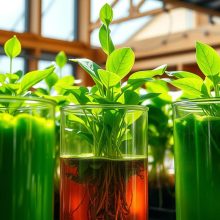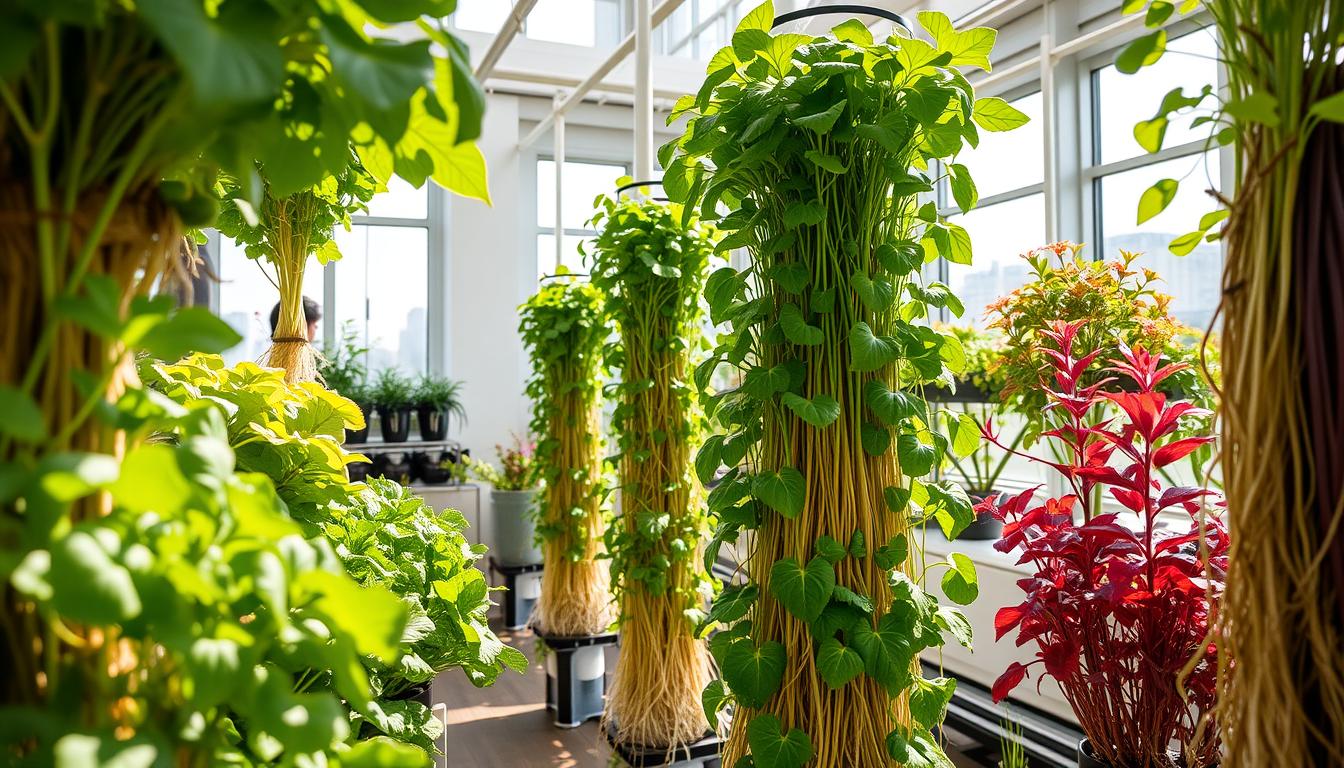Vertical Farming: The Future of Sustainable Agriculture
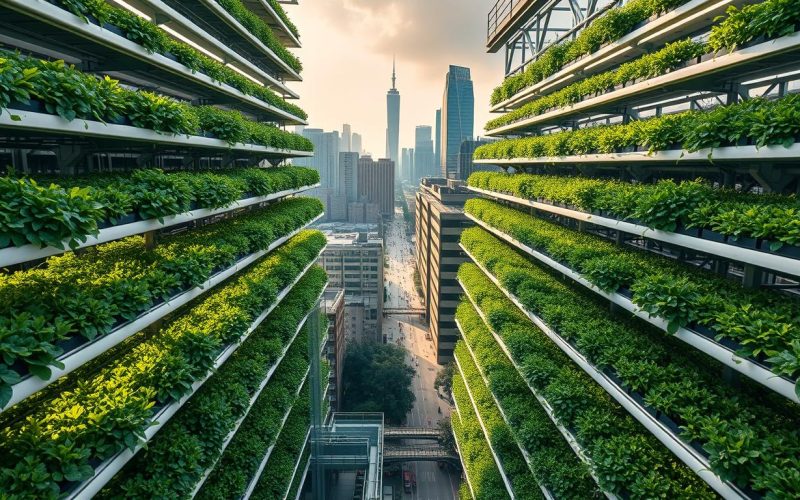
Global agriculture is at a turning point. Vertical farming is a new solution for food in crowded cities. It grows crops in layers, using space well and saving resources.
Vertical farming is a big step up in farming technology. It uses indoor spaces to grow crops all year, without needing soil. This makes food fresh and healthy.
As the world’s population grows, food production is under strain. Vertical farming is a way to ensure food for everyone. It uses new tech like hydroponics and climate control to change how we grow food.
Key Takeaways
- Vertical farming enables crop production in compact urban spaces
- Reduces water consumption compared to traditional agriculture
- Provides year-round crop production independent of seasonal changes
- Minimizes transportation costs and carbon emissions
- Creates opportunities for local, sustainable food systems
What is Vertical Farming?
Vertical farming is a new way to grow food indoors. It stacks crops in layers, often in places like warehouses. This method is part of controlled environment agriculture.
This approach makes the most of small spaces. It uses special growing methods to pack crops tightly. This way, farmers can grow more food than before.
Defining Vertical Farming
Vertical farming is a smart way to grow crops. It stacks them in layers and uses new technologies. These systems control the environment for the best growth.
- Grows crops in vertically stacked layers
- Utilizes controlled indoor environments
- Minimizes land and water consumption
- Enables year-round crop production
Key Characteristics of Vertical Farms
Vertical farms have key features that set them apart. They use the latest technology to create perfect growing spots.
- Precise climate control
- Artificial lighting optimization
- Hydroponic or aeroponic growing systems
- Minimal water and nutrient usage
- Reduced environmental impact
Vertical farming combines new tech with green farming. It’s a big step towards solving food production problems. It’s efficient and good for the planet.
The Benefits of Vertical Farming
Vertical farming is a new way to farm that’s good for the planet, our wallets, and our communities. It changes how we grow food by using cool tech to solve big problems in farming.
Environmental Advantages
Vertical farming is great for the environment. It uses way less water than old-school farming. Here are some big wins for our planet:
- Up to 95% less water usage than conventional agriculture
- Minimal land requirements for crop production
- Reduced carbon footprint through localized food systems
- Elimination of pesticide and herbicide usage
Economic Opportunities
Vertical farming is also a smart move for businesses and cities. It brings in big money with its advanced tech:
- Year-round crop production independent of seasonal constraints
- Higher crop yields per square foot
- Reduced transportation costs
- Lower labor expenses through automated systems
Community Social Impact
Vertical farming does more than just save the planet and make money. It also changes lives. It helps solve hunger, creates jobs, and brings people closer to their food.
By farming vertically in cities, we can tackle today’s farming problems. We get fresh, local food and help our communities and the planet thrive.
How Vertical Farming Works
Vertical farming is a new way to grow food, even in small spaces. It uses advanced tech to make growing crops efficient and green.
Modern vertical hydroponics helps farmers grow more food with less resources. The heart of these systems is top-notch farm tech that makes the best growing conditions.
Comparing Hydroponic Approaches
There are two main ways to grow crops in vertical farming:
- Hydroponics: Plants grow in water full of nutrients, no soil needed
- Aeroponics: Crops hang in the air and get misted with nutrients
Cutting-Edge Farm Technologies
Vertical farming uses many advanced technologies for the best plant growth:
- LED lighting for the right light spectrum
- Automated climate control systems
- Systems for precise nutrient delivery
- Data analytics for always watching over crops
These tech advancements help vertical farms grow top-quality crops. They use much less water and land than old farming ways.
Challenges Facing Vertical Farming
Vertical farming is a new way to grow food, but it faces big challenges. To become common, it needs smart solutions and ongoing tech improvements.
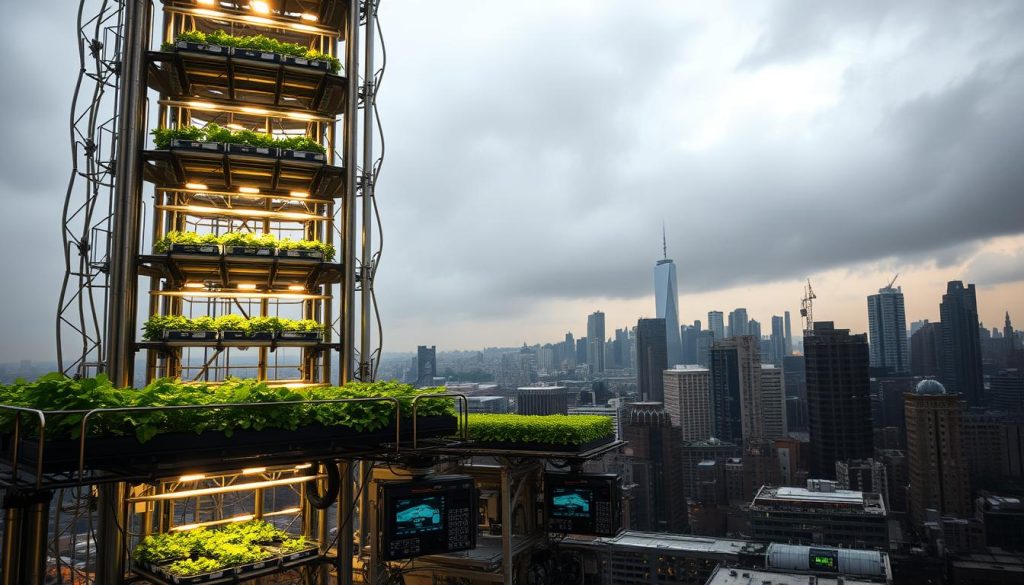
Creating lasting vertical farms needs a lot of money and know-how. People starting these farms must overcome many hurdles to succeed.
High Initial Investment Costs
Starting a vertical farm costs a lot of money. It needs advanced tools and setup:
- Advanced LED lighting systems
- Precision climate control mechanisms
- Automated nutrient delivery systems
- Specialized vertical growing structures
These costs can be hundreds of thousands to millions of dollars. This makes it hard for small farms and new businesses to start.
Technical Maintenance and Support
Vertical farming needs special skills and upkeep. The tech used in these farms requires:
- Ongoing monitoring of environmental conditions
- Regular calibration of technological systems
- Skilled technicians with expertise in agricultural technologies
- Continuous software and hardware updates
Because of its tech complexity, vertical farming needs constant training and support. This ensures the farm runs well and produces food efficiently.
The Role of Vertical Farming in Urban Areas
Urban farming is changing how cities grow food. Vertical greenhouses are key to solving big city problems. They turn empty spaces into places where food grows.
Vertical farming does more than just grow food. Cities struggle to get fresh, healthy food, mainly in food deserts.
Solving Urban Food Accessibility
Vertical farming tackles urban food issues:
- It brings fresh produce right to city centers
- It cuts down on food transport
- It creates jobs in urban farming
- It uses spaces like rooftops and old buildings
Environmental Benefits in Urban Settings
Vertical greenhouses cut down on emissions by bringing food closer to people. One square foot of vertical farm can grow a lot more than traditional farming.
Cities using urban farming see big environmental wins. These new farming ways lower carbon emissions and boost local food production.
Successful Vertical Farming Case Studies
The world of vertical farming has seen big wins. These wins show how indoor agriculture can change the game. They are leading the way in growing food in cities.
Companies in vertical farming are showing that green farming can also be smart and profitable. Two examples stand out, showing how far this field has come.
Bowery Farming: Urban Agriculture Innovation
Bowery Farming is a top name in vertical farming tech. They use advanced indoor farming to send fresh food to over 1,100 stores in the U.S. Their big wins include:
- Using AI for crop monitoring
- No pesticides needed
- Less water used than traditional farming
AeroFarms: Scaling Hydroponic Solutions
AeroFarms is another big success in vertical farming. They’ve gotten a lot of investment for their new farming tech. Their big moves include:
- Special aeroponic growing systems
- Big indoor farms
- Food grown all the time, no matter the weather
These stories show how vertical farming is changing farming for the better. It’s making food production in cities more sustainable.
Future Trends in Vertical Farming
The world of farming is changing fast with new tech. Vertical farming is leading this change, offering new ways to grow food. It’s a big step towards solving global food problems.
New tech is making vertical farming even better. It’s opening up new chances for growing food in a green way. Experts are working on new vertical farming systems. They use the latest tech to make farming more efficient.
Smart Farming Technologies Driving Innovation
Vertical farming’s future is all about tech. Some big changes include:
- Internet of Things (IoT) sensors for real-time crop monitoring
- Artificial intelligence for optimizing growing conditions
- Machine learning algorithms to predict crop yields
- Automated climate control systems
Global Market Potential
The vertical farming market is growing fast. This is because of several important reasons:
- More people living in cities
- Adapting to climate change
- More demand for local food
- New tech making farming cheaper
As tech keeps getting better, vertical farming will play a big role in farming worldwide. It offers a way to grow food that’s good for the planet and efficient.
The Nutritional Value of Vertically Farmed Produce
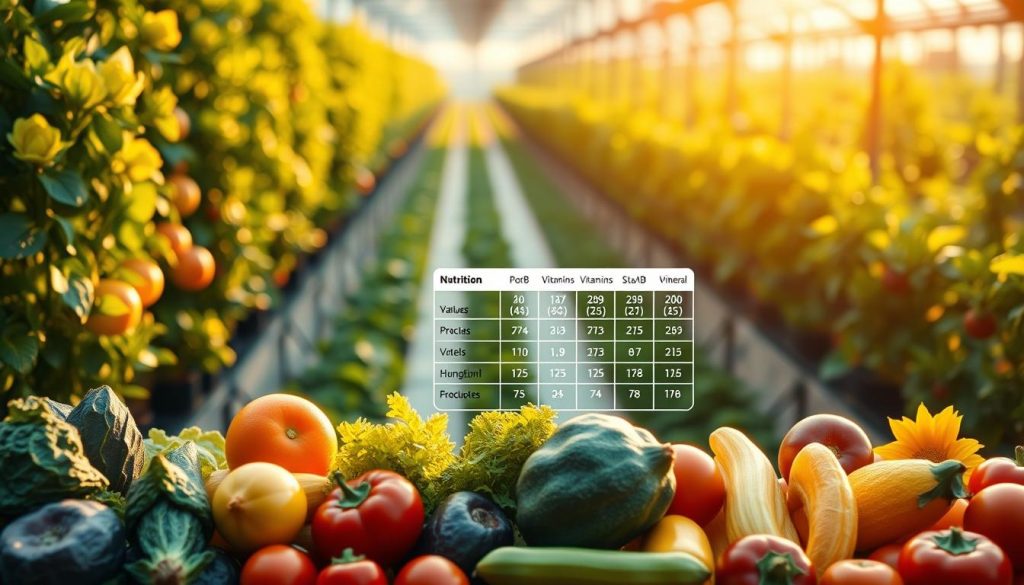
Vertical farming is a new way to grow food that’s good for the planet and for us. People are curious about the health benefits of food grown this way.
Vertical farming uses special techniques to make sure crops are as nutritious as possible. Studies show that these crops can be just as good for you as the ones grown the old-fashioned way.
Nutrient Comparison with Conventional Crops
Here are some important points about the nutrition in vertical farming:
- Controlled growing environments minimize nutrient degradation
- Precise monitoring allows optimization of crop mineral content
- Reduced transportation time preserves vitamin and mineral levels
- Elimination of pesticides maintains cleaner nutritional profiles
Organic Certification Challenges
Getting organic certification for vertical farming is tricky. The U.S. Department of Agriculture is still figuring out the rules. They need to look at how crops are grown, what nutrients they get, and how they’re controlled.
Even though vertical farming is a step in the right direction, we still have a lot to learn. More research is needed to understand its health benefits and how to get it certified.
Education and Training in Vertical Farming
Vertical farming is growing fast, and it needs more skilled people. The industry needs experts who know how to work in controlled environments. This is because farm technology keeps getting better.
Now, there are many ways to learn about vertical farming. Schools and farms are offering programs that mix theory and practice. These programs help students get ready for the job market.
Educational Programs and Workshops
- Associate and bachelor’s degree programs in sustainable agriculture
- Specialized certification courses in vertical farming technologies
- Online workshops focusing on hydroponic and aeroponic systems
- Technical training in farm technology and crop management
Skill Development in Vertical Farming
Vertical farming needs people with many skills. Students must learn about plants, the environment, data, and technology. They need to know how to manage crops, control the climate, and make nutrient solutions.
- Crop management techniques
- Climate control systems
- Nutrient solution development
- Automation and monitoring technologies
Schools are working with farms to make their programs better. This way, students are ready for the challenges of sustainable farming. They learn from the best in the field.
How You Can Support Vertical Farming Initiatives
Vertical farming is a new way to farm that needs our help. We can all support it by learning about it and taking action. This helps it grow in our communities.
Start by spreading the word and making smart choices when you shop. Look for local vertical farms and buy their produce. Tell your friends and family about its benefits for the planet. Your choices can help make more people want to support it.
Community Engagement Strategies
Get involved with your local government and urban planners. Go to city council meetings and write to your representatives. Ask for rules that help vertical farms grow.
By talking up vertical farming, we can make policies that support it. This helps these farms succeed in cities.
Driving Policy Change
We can all make a difference in vertical farming’s future. Join groups focused on agriculture, go to workshops, and support research. Your help can push for big changes in how we farm in cities.
